 Overview
Overview
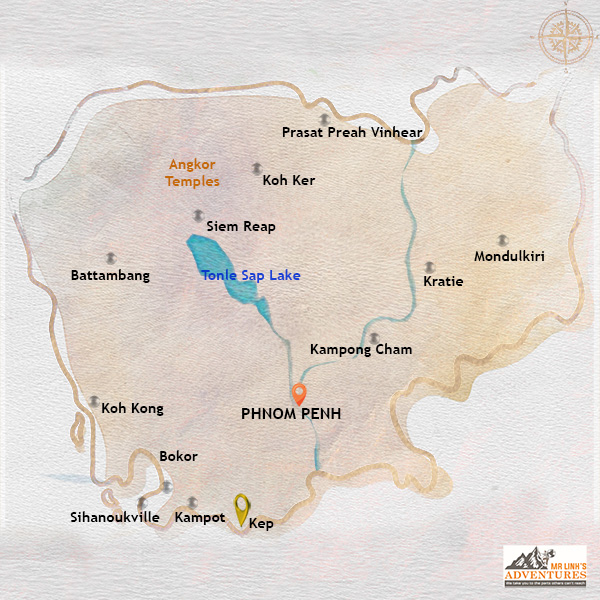 Kep
Kep, a serene coastal town in Cambodia, boasts a rich history as a premier seaside destination. Initially a favored retreat for French colonists and subsequently affluent Cambodians, Kep flourished in the early 20th century, earning its reputation as Cambodia's most prestigious resort.
In recent years, Kep has experienced a resurgence in popularity, attracting travelers who desire an off-the-beaten-path coastal experience. Its allure lies in its tranquil atmosphere and the promise of a laid-back Cambodian lifestyle.
What truly sets Kep apart are its picturesque offshore islands. These islands provide the perfect springboard for maritime adventures, from island hopping and snorkeling to exploring pristine beaches. This allows visitors to seamlessly blend thrilling sea excursions with the town's inherent sense of calm and relaxation. Kep offers a unique blend of historical charm, natural beauty, and a peaceful escape from the bustling tourist trails.
 Top Attractions
Top Attractions
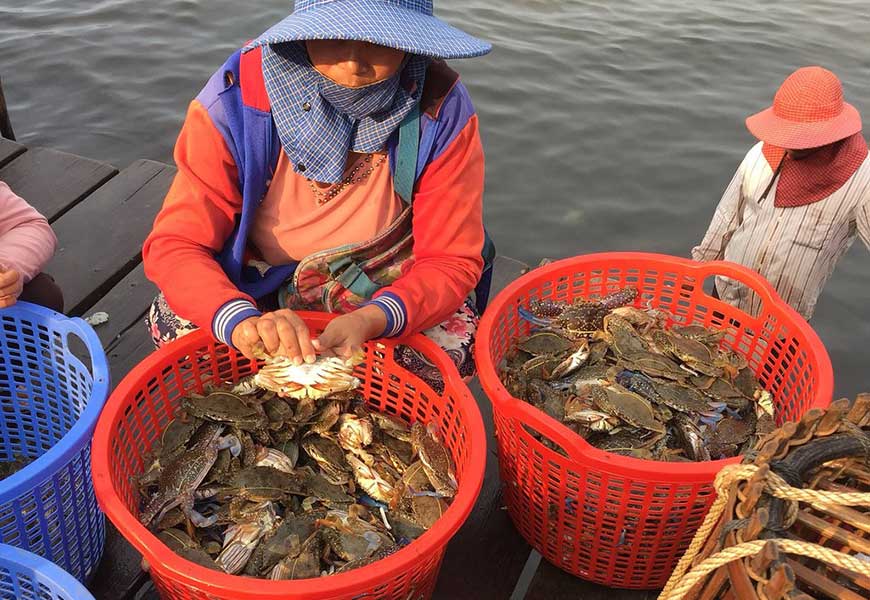 Woman selling crabs at crab market
Woman selling crabs at crab market
Beyond its historical charm and tranquil ambiance, Kep offers a delightful array of attractions for visitors to enjoy!
Crab Market
A visit to Kep isn't complete without experiencing its Crab Market. Here, you can immerse yourself in the vibrant local atmosphere and savor Kep's renowned crabs. These delicious crustaceans are freshly caught and prepared according to traditional recipes, offering an authentic taste of the region.
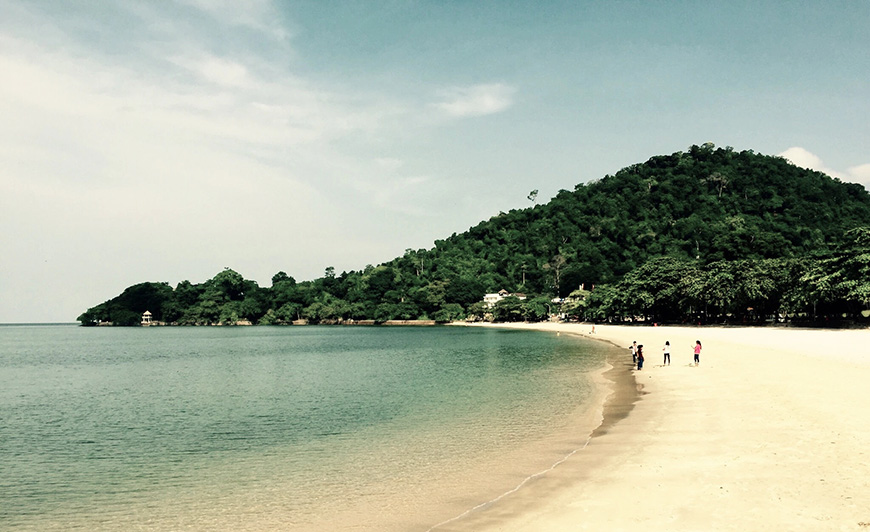 This picturesque beach is famous for its soft sand and turquoise waters
This picturesque beach is famous for its soft sand and turquoise waters Kep Beach
For a quintessential beach experience, head to Kep Beach. Stretch out on its soft sands, take a refreshing dip in the turquoise waters of the Gulf of Thailand, and be sure to stay for the truly spectacular sunset that paints the sky with vibrant hues.
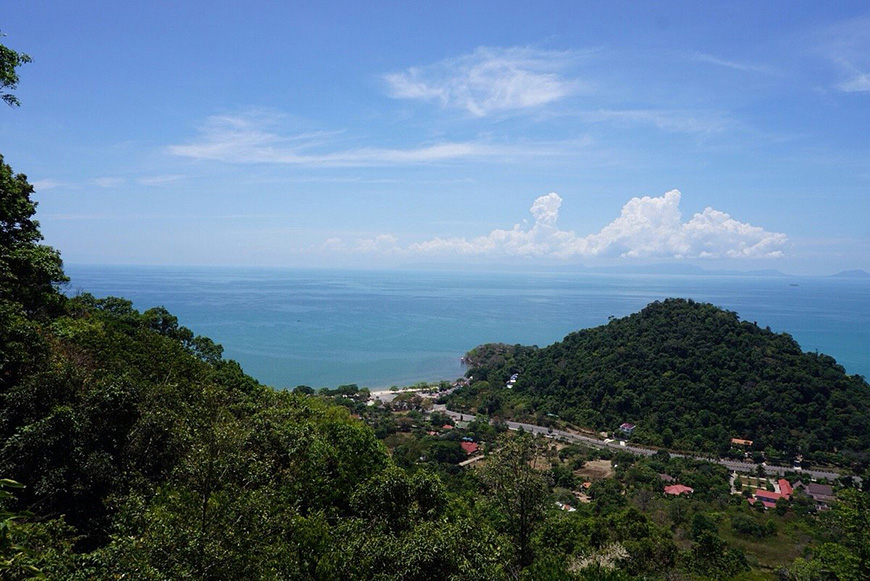 Kep National Park, where to enjoy panoramic views of the coast and surrounding islands
Kep National Park, where to enjoy panoramic views of the coast and surrounding islandsKep National Park
Nature enthusiasts will love Kep National Park, a lush nature reserve teeming with diverse flora and fauna. Hike through its verdant trails and discover panoramic views of the coast and the surrounding islands, a perfect blend of adventure and scenic beauty.
 Take a boat trip to this idyllic island, where you can lounge on pristine beaches, snorkel, and savor freshly grilled seafood
Take a boat trip to this idyllic island, where you can lounge on pristine beaches, snorkel, and savor freshly grilled seafoodRabbit Island (Koh Tonsay)
Embark on a memorable boat trip to Rabbit Island (Koh Tonsay), an idyllic island escape. Once there, you can lounge on pristine beaches, snorkel in the clear waters, and feast on freshly grilled seafood right by the shore. It's the perfect day trip for relaxation and natural beauty.
 See & Do
See & Do
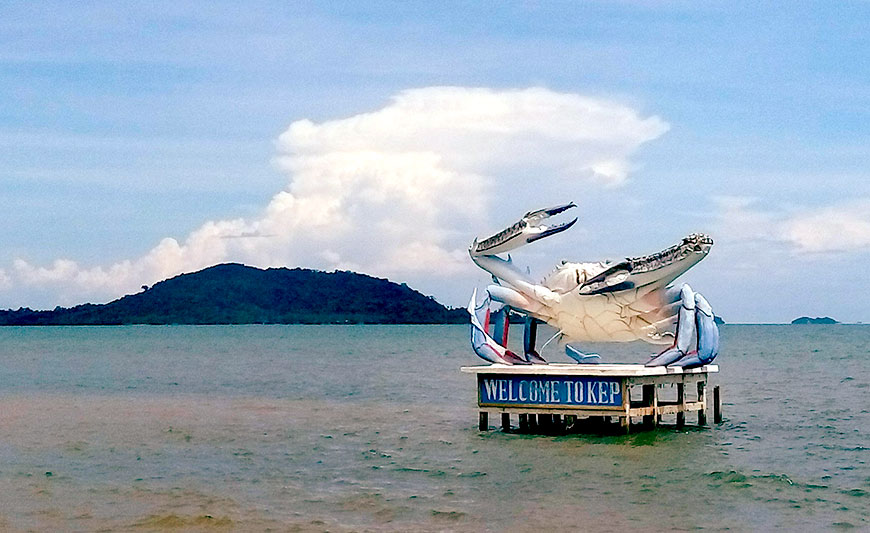 Krung Kep Blue Swimmer Crab Statue, the Kep City Emblem
Krung Kep Blue Swimmer Crab Statue, the Kep City Emblem
Many people come to Kep to relax on its main beach, Kep Beach. This one-kilometer stretch of white sand, shaped like a picturesque crescent, is ideal for sunbathing or swimming. Behind the beach, a promenade offers a wide range of restaurants serving fresh seafood and the famous Kep crab.
 The Discovery Centre of Knai Bang Chatt is the first official Sailing Club in Cambodia
The Discovery Centre of Knai Bang Chatt is the first official Sailing Club in Cambodia
For those wishing to indulge in water activities, the Knai Bang Chatt Sailing Club offers regular sailing lessons. Other water sports are also available, including kayaking, windsurfing, and Hobie Cat catamaran sailing.
The islands of Kep, meanwhile, offer a mix of secluded beaches and rustic charm, ideal for discovering Cambodia from a different perspective. Koh Tonsay (Rabbit Island), the most developed island in the archipelago, is served regularly by shuttles from Kep. Its pretty, popular beaches are equipped with hammocks and sun loungers for lazy afternoons. They also offer a wilder side, with their few wooden huts where simple dishes of fresh seafood are served. It's the perfect place to stroll and watch the locals go about their daily lives, mainly focused on fishing. The more athletic can tour the island in two or three hours. It is also possible to rent snorkeling equipment to admire the coral reefs and multicolored fish that populate the waters off the island. In the evening, don't miss the magical spectacle of phosphorescent algae that illuminate the sea!
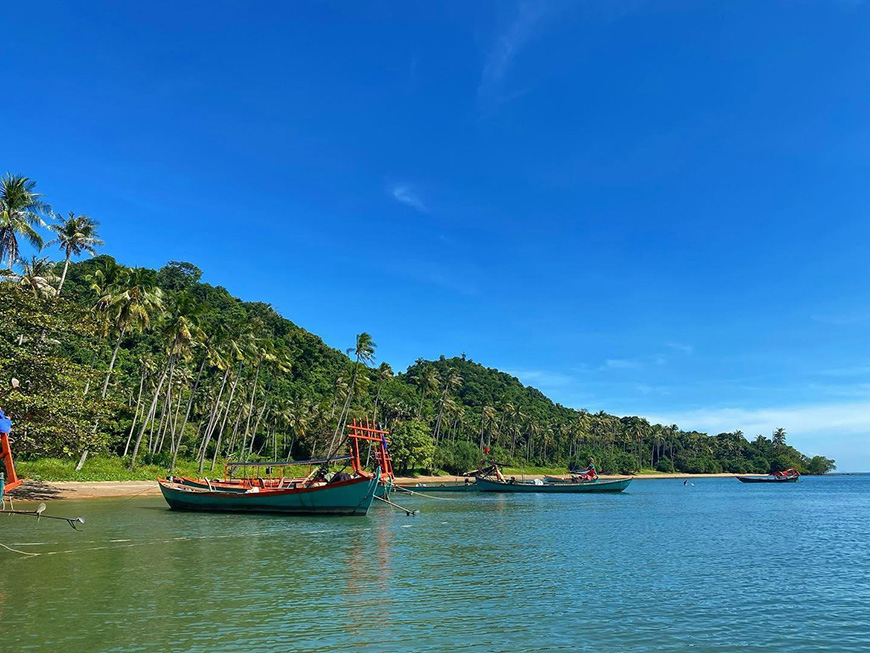 Koh Po - often called Koh Svay Prey - has a deserted beach and fine snorkelling
Koh Po - often called Koh Svay Prey - has a deserted beach and fine snorkelling
Beyond Koh Tonsay, other, much less frequented islands of Kep are accessible from the latter or from the mainland. Koh Pos (Snake Island) is home to a traditional fishing community and a pretty white sand beach.
The most beautiful beach in the province, Angkaul Beach, is about 45 minutes from the town of Kep. This stretch of white sand of almost 2 km, away from the beaten track, is a real hidden gem of Cambodia. There is white sand, shallow waters for paddling and some sun loungers and umbrellas to relax.
 Sunset Rock is noted for its stunning sunset views of the town and shoreline
Sunset Rock is noted for its stunning sunset views of the town and shoreline
One of the major attractions of the province of Kep is undoubtedly the Kep National Park. Covering 50 km², it offers a range of trails and points of interest, perfect for day trips from the beach. The main trail, 8 km long, can be explored on foot, by bike or even by motorbike. To prepare for your adventure, the Led Zep Café offers breakfast and a detailed map of the park's trails.
In addition to the main circuit, many trails also delve into the depths of the park. The "Stairway to Heaven" trail, inspired by the famous band Led Zeppelin, is particularly popular with visitors as it leads to the Wat Samanthi Pagoda and the Sunset Rock viewpoint. All along the trails, the panoramas of the coastline, the islands and the surrounding mountain ranges are simply breathtaking.
The Kep Butterfly Garden is another attraction of the national park. In addition to a dome housing a multitude of brightly colored butterflies, it has a nursery showing all stages of butterfly development. The garden also includes benches and koi carp ponds in peaceful corners, conducive to relaxation and meditation.
Not far away, Phnom Sar Sear, a set of three mountains home to many fascinating caves, is a popular destination. The most popular are Phnom Ach Prochiev and Phnom Dorei Sar, which also has a mountain well. In addition to the caves, the mountain is home to nuns, monks and a Buddhist pagoda.
 Go Green
Go Green
Mr Linh's Adventures offers tailor-made tours to discover the wonders of Kep and its surroundings:
Trekking in Kep National Park: Explore the local flora and fauna, discover hidden waterfalls and enjoy panoramic views of the coast.
Boat trip to Rabbit Island: Relax on dream beaches, snorkel and enjoy a delicious seafood lunch.
Discovery of Kampot pepper plantations: Visit a pepper plantation and learn more about the cultivation of this emblematic spice of Cambodia.
Immersion in local culture: Meet the locals, visit fishing villages and discover local crafts.
 Heritage
Heritage
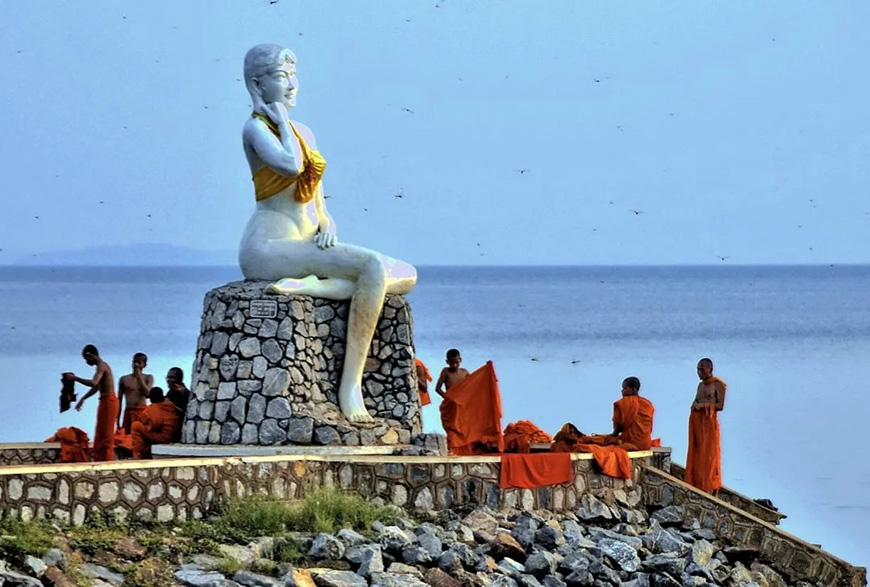 Sela Cham P'dey is a statue of a nude fisherman's wife looking out to sea, waiting for her husband to return
Sela Cham P'dey is a statue of a nude fisherman's wife looking out to sea, waiting for her husband to returnAs a small, sleepy seaside resort, the main pastimes in Kep are the beach, food and outdoor life. It is therefore not a destination for lovers of art and culture, but a few points of interest are worth mentioning.
Kep retains vestiges of its colonial past in its architecture and urban planning. One can still find a hundred houses dating from this period scattered around the town, some of which have been renovated while others are abandoned. Many modernist mansions, built as retreats for the wealthy of Phnom Penh in the 1950s and 1960s, also dot the coastline. Architecture enthusiasts will enjoy a walk or tuk-tuk ride in Kep, where magnificent French colonial houses and villas remain. Some, abandoned, give the city an atmosphere of another era. Be sure to visit the Don Bosco Birthplace Memorial, which recreates the birthplace of this 19th-century priest, educator and writer.
One of the most visible works of art in Kep is the statue of Sela Cham P'dey, located on a promontory overlooking the sea. This sculpture depicts a naked fisherman's wife, gazing at the horizon in anticipation of her husband's return. It pays tribute to the region's strong fishing traditions.
Kep also has a fun crab statue, perched on a platform above the water. Famous for its crab-based specialties, this statue is a tribute to the local gastronomy that attracts many visitors.
 Food & Drinks
Food & Drinks
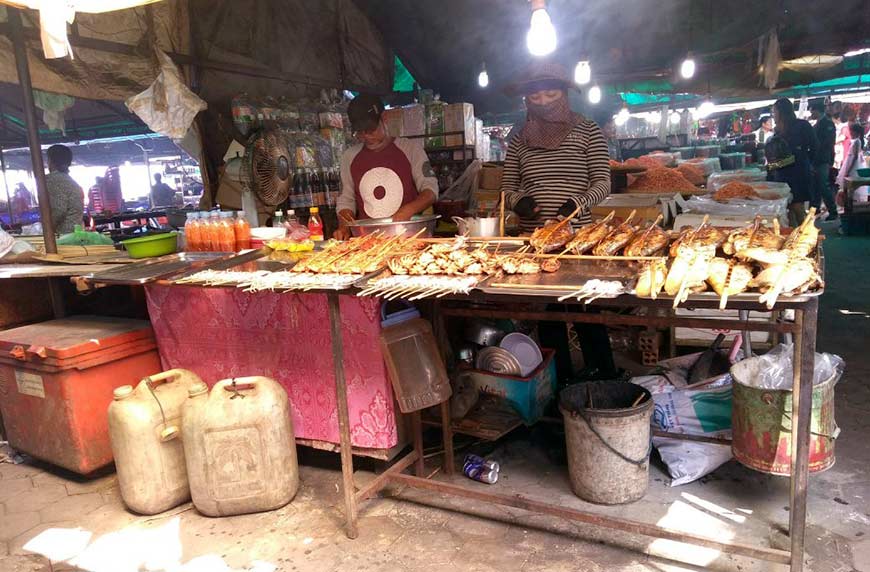 Stand of crab barbecue, Kep Crab Market
Stand of crab barbecue, Kep Crab Market
This region of Cambodia is world famous for a variety of exceptional black pepper: Kampot pepper. During your stay in Kep or the neighboring province of Kampot, do not miss the opportunity to visit the local pepper plantations to learn more about its cultivation and specificities. In Kep, the Sothy's Pepper Farm welcomes you for a guided tour of the plantation, revealing all the secrets of Kampot pepper. You can also take advantage of your visit to do some shopping at the farm shop.
In addition to its exceptional pepper, Kep is also famous for its fresh crabs. The crab market is the ideal place to taste this local specialty. Located near the fish market, it brings together a multitude of restaurants where you can savor freshly caught crabs, seasoned with Kampot pepper. It is an unmissable place, popular with locals and visitors alike, and which will not fail to delight your taste buds!
Do not miss to taste the Kdam Chaa, made from fresh crab sautéed with Kampot pepper, garlic and soy sauce. Or why not try the Kep blue crab, often infused with Kampot pepper, to be enjoyed with an Angkor beer.
 Directions
Directions
Location
Kep is located in southern Cambodia, about 170 km from Phnom Penh and 300 km from Sihanoukville.
How to get there
You can reach Kep by bus, taxi or private car from Phnom Penh or Sihanoukville.
Best season to visit
The dry season, from November to April, is the ideal time to visit Kep, as the weather is sunny and the temperatures are pleasant.